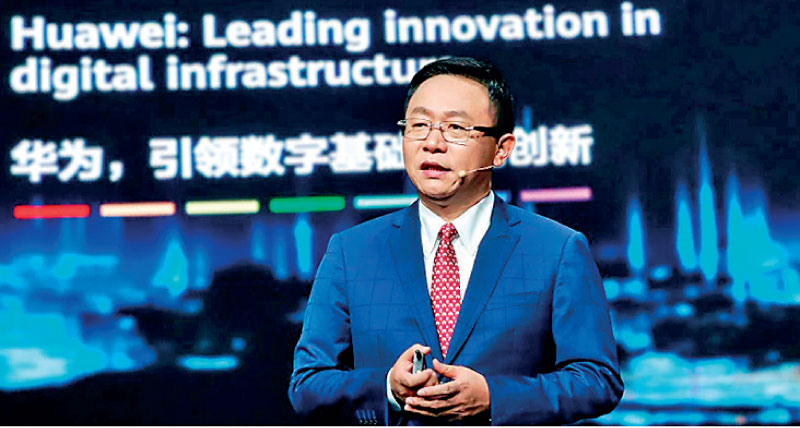Thursday Dec 12, 2024
Thursday Dec 12, 2024
Monday, 4 October 2021 02:18 - - {{hitsCtrl.values.hits}}

Huawei Executive Director and President of ICT Products & Solutions David Wang
The objects and boundaries of network connectivity will continue to expand in the next decade and by 2030, as technologies such as XR, naked-eye 3D display, digital touch, and digital smell, develop further, a report has said.
Digital vision, digital touch, and digital smell will create an immersive and disruptive experience through next-generation networks, added the Intelligent World 2030 Report released by Huawei, a global provider of ICT solutions.
Huawei Executive Director and President of ICT Products & Solutions David Wang released the report at the recently held Intelligent World 2030 Forum.
The report proposes eight cross-disciplinary and cross-domain directions for exploration at the macro level. It explains how ICT technologies can solve critical problems and challenges of human development, and what new opportunities can be brought to organisations and individuals. At the industry level, the report explores the future technologies and development directions of communications networks, computing, digital power, and intelligent automotive solutions.
Wang said: “30 years ago, we decided to enrich life through communications. 10 years ago, we decided to connect every corner of the world, to build a better, connected world. Now, our vision and mission is to bring digital to every person, home, and organisation for a fully connected, intelligent world. We firmly believe that a brilliant intelligent world is arriving at an accelerated pace.
“We believe, the greatest wisdom is found in shared ideas. Dreams are the key driver of social progress. Moving towards the next decade, let's work together to shape a better, intelligent world.”
Overview of the report
Outlooks for the intelligent world 2030:
Communications Network 2030
As networks evolve from connecting billions of people to hundreds of billions of things, network design will change from focusing on human cognition to machine cognition.
“We will see an emergence of multi-level computing infrastructure for hundreds of billions of things and massive data, as well as computing power networks that provide connectivity. In addition, four future network scenarios will gradually become a reality. They are the networks that will deliver a consistent experience for homes, offices, and vehicles, satellite broadband Internet, industrial Internet, and computing power network,” the report said.
As part of the intelligent world, the communications network of 2030 will evolve towards cubic broadband networks, deterministic experience, AI-native, HCS, security and trustworthiness, and green and low-carbon networks.
Huawei predicts that the total number of global connections will reach 200 billion by 2030. At the same time, enterprise network access, home broadband access, and individual wireless access will exceed 10 Gbit/s, ushering in an era of 10 Gbit/s connectivity.
Computing 2030
By 2030, the digital and physical worlds will be seamlessly converged, allowing people and machines to interact perceptually and emotionally. AI will become ubiquitous and help us transcend human limitations. It will serve as microscopes and telescopes of scientists, enhancing our understanding of everything from the tiniest quarks to the largest cosmological phenomena.
Industries already making extensive use of digital technology will become more intelligent with AI. Computing energy efficiency will increase dramatically, bringing us closer to zero-carbon computing. Digital technologies can become a tool for achieving the global goal of carbon neutrality.
Computing is approaching its physical limits, so innovation in software, architecture, and systems are needed. More importantly, the entire industry needs to jointly explore a new foundation for computing, break through the physical limits of semiconductors, and make computing greener, more secure, and more intelligent. Huawei predicts that by 2030, humanity will enter the yottabyte data era, with general-purpose computing power increasing by 10 times and AI computing power by 500 times.
Digital Power 2030
In the next decade, humanity will enter the digital power era, striving towards low-carbon development, electrification, and intelligent transformation. New renewable energy sources, such as photovoltaic and wind power, will gradually replace fossil fuels. Power, electronic technology and digital technology are being deeply converged to enable ‘bit to manage watt’ throughout the energy system and realise various intelligent applications on the ‘energy cloud’.
Huawei predicts that by 2030, solar energy will become one of our main power sources, the proportion of renewables in global electricity generation will be 50%, the share of electricity in final energy consumption is expected to exceed 30%, electric vehicles as a proportion of new vehicles sold will exceed 50%, and renewable energy will power 80% of digital infrastructure.
Intelligent Automotive Solution 2030
In the next decade, electrification and intelligence will be unstoppable, and ICT technologies will converge with the automotive industry. The automotive industry will witness the development of intelligent driving, intelligent spaces, intelligent services, and intelligent operations. Huawei hopes to use its ICT technologies to enable an intelligent automotive industry and help carmakers build better vehicles.
The ultimate goal of intelligent driving is to use technologies such as autonomous driving to greatly reduce the incidence of traffic accidents and deliver efficient and seamless travel experiences to users. Intelligent driving has so far been mainly limited to closed roads like high-speed roads and campus roads, but it will gradually see more application on public roads, such as those in urban areas. Vehicles will become a new intelligent space.
With the support of ICT, technologies like AI, biometric recognition, in-vehicle optical sensors, and AR/VR will bring new features to the cockpit. Intelligent vehicles will truly transform from a flexible mobile space to an intelligent living space that integrates the virtual and physical worlds.
Huawei predicts that, by 2030, autonomous vehicles will account for 20% of new vehicles sold in China, electric vehicles will account for more than 50% of new vehicles sold, vehicles will come equipped with computing power of over 5,000 TOPS, and in-vehicle network transmission speed per link will exceed 100 Gbps.